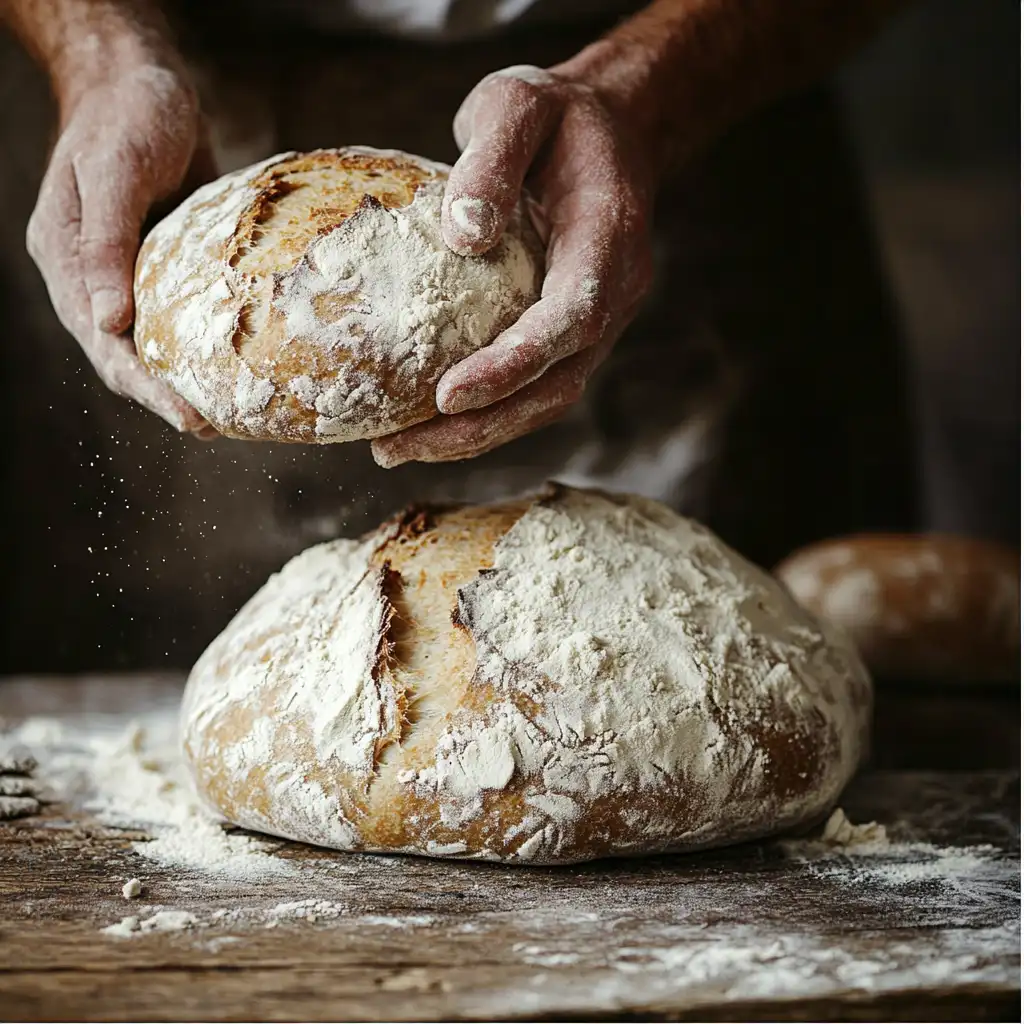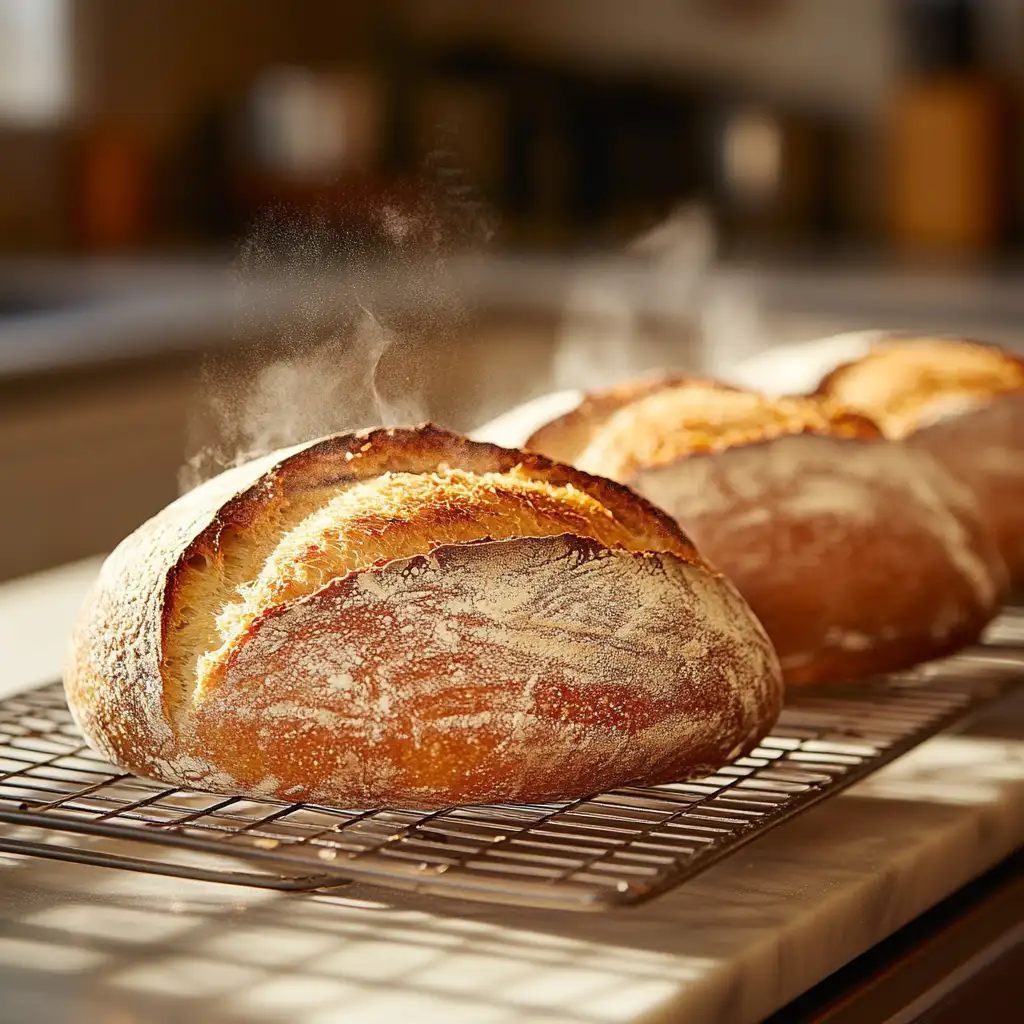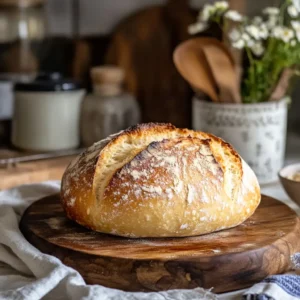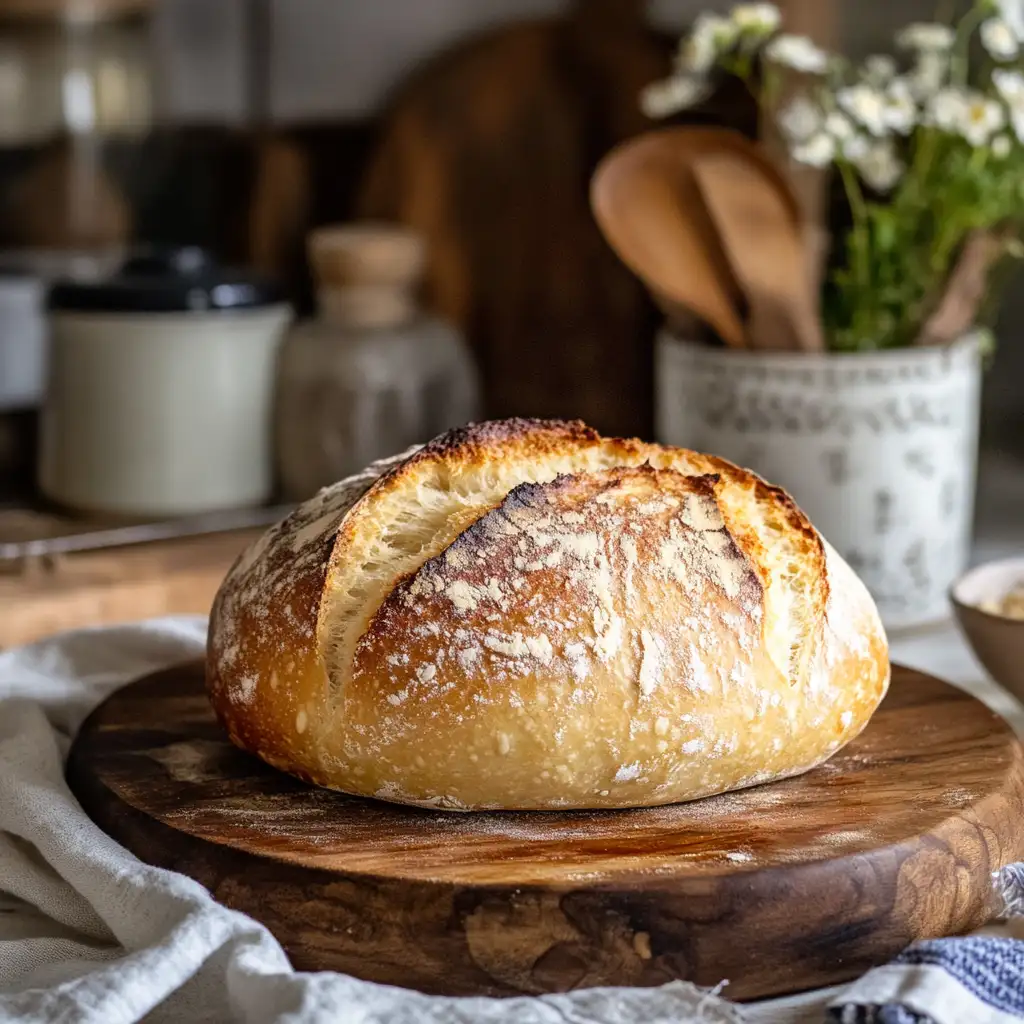Table of Contents
When it comes to homemade bread, sourdough often steals the show with its irresistible flavor and rustic charm. But what if you don’t have a sourdough starter on hand? No worries, this guide is your ultimate solution! In this article, we’ll walk you through an easy and foolproof sourdough bread recipe without starter, perfect for beginners and seasoned bakers alike. You’ll discover how to create delicious, tangy sourdough bread without the hassle of maintaining a traditional starter, all while learning the tools, tips, and techniques to make the process a breeze. Let’s dive into the world of starter-free sourdough!
Why Make Sourdough Bread Without a Starter?
Simplifying Traditional Sourdough Baking
Traditional sourdough bread requires a starter, a fermented mix of flour and water that takes days (sometimes weeks!) to cultivate. While the result is worth it, the process can feel daunting if you’re short on time or new to baking. By using this starter-free sourdough bread recipe, you can skip the lengthy fermentation process while still achieving a loaf that’s soft, flavorful, and beautifully golden.
This method is perfect for anyone who loves homemade bread but doesn’t want to commit to the upkeep of a starter. Think of it as the no-fuss shortcut to achieving sourdough perfection without sacrificing quality!
Perfect for Beginners Without Time or Equipment
Not everyone has the luxury of fancy equipment like proofing baskets or Dutch ovens, or even the patience for multiple feedings to keep a sourdough starter alive. With this method, all you need are basic ingredients, a little creativity, and some simple tools you likely already have in your kitchen. Plus, it’s a great way for beginners to dip their toes into the world of sourdough baking without getting overwhelmed.
So, why wait? If you’re eager to enjoy fresh, homemade sourdough bread without the hassle of traditional starters, this recipe is exactly what you need. Ready to learn more? Keep reading to discover everything you need to know!
What You’ll Need for Starter-Free Sourdough Baking
Tools and Equipment Checklist
Creating the perfect sourdough bread recipe without starter doesn’t require a kitchen full of gadgets. You likely have most of the essentials at home already! Here’s what you’ll need:
- Mixing Bowl: For combining and kneading your dough.
- Measuring Cups and Spoons: Precise measurements are key to nailing bread-making.
- Parchment Paper: Helps prevent sticking and makes cleanup a breeze.
- Oven-Safe Dish or Baking Sheet: Don’t worry about fancy Dutch ovens, though they’re great, a regular baking sheet works too!
Do you need a Dutch oven for sourdough bread? Not necessarily! While a Dutch oven creates a steamy environment for crusty bread, you can mimic this by placing a small pan of water in the oven during baking. It’s all about working with what you have!
If you’re looking for more ideas on making simple and delicious recipes with minimal tools, check out the banana bread recipe without butter for inspiration.
Ingredients Breakdown
The beauty of this recipe is in its simplicity. Here’s a breakdown of the ingredients you’ll need:
- Flour: All-purpose or bread flour works best for structure and chew.
- Yeast: Active dry yeast replaces the traditional starter here.
- Water: Warm water helps activate the yeast.
- Salt: Enhances the flavor of the bread.
- Optional Add-Ins: A touch of honey or sugar can add a subtle sweetness.
Can you start sourdough with regular flour? Absolutely! All-purpose flour is versatile and works well in starter-free recipes. For added texture, you could mix in whole wheat or rye flour.
Starter-Free Techniques for Achieving the Perfect Loaf
Yeast-Based Sourdough: A Modern Take
If you’re wondering how to mimic the tangy flavor of sourdough bread without a starter, yeast is your best friend. It serves as a shortcut to achieve a similar rise and texture. Simply activate the yeast with warm water and a touch of sweetener (like honey) to get things bubbling. This quick fermentation process skips the starter while still delivering delicious results.
Here’s the trick: Add a little yogurt or vinegar to the dough to mimic the tangy flavor of traditional sourdough. It’s a simple hack that works wonders!
Natural Fermentation Without a Starter
Want to go the extra mile and rely on wild yeast from your kitchen? This method requires patience but can be rewarding. By mixing flour and water and leaving it uncovered, you allow natural fermentation to take place. Over time, the dough will develop a subtle sourdough-like flavor.
It’s like giving nature a helping hand, just remember, this method takes longer. If you’re in a hurry, stick with the yeast-based approach for quicker results.
Recipe 🌟 – How to Make the Perfect Sourdough Bread Recipe Without Starter
Step-by-Step Instructions
This sourdough bread recipe without starter is easy to follow and perfect for anyone looking to enjoy homemade bread with minimal effort. Let’s dive into the process:
- Activate the Yeast
- In a small bowl, mix 1 ½ cups of warm water, 2 teaspoons of active dry yeast, and 1 tablespoon of honey (optional). Let it sit for 5–10 minutes until frothy.
- Prepare the Dough

- In a large mixing bowl, combine 4 cups of flour (all-purpose or bread flour) and 1 ½ teaspoons of salt. Gradually add the yeast mixture, stirring until a shaggy dough forms.
- Knead the Dough
- Turn the dough onto a floured surface and knead for 8–10 minutes until smooth and elastic. Alternatively, use a stand mixer with a dough hook for convenience.
- First Rise
- Place the dough in a lightly greased bowl, cover it with a damp cloth, and let it rise in a warm place for 1–2 hours or until it doubles in size.
- Shape the Dough
- Punch down the dough and shape it into a round loaf or oval. Transfer it onto a parchment-lined baking sheet.
- Second Rise
- Cover the shaped dough with a damp towel and let it rise for another 30–45 minutes.
- Bake

- Preheat your oven to 450°F (230°C). If you don’t have a Dutch oven, place a small pan of water on the bottom rack to create steam. Bake the bread for 25–30 minutes, or until golden brown.
- Cool and Serve
- Let the bread cool on a wire rack before slicing. Enjoy fresh slices with butter or your favorite spread!
Variations and Tips
- Flavor Boosts: Add 1 teaspoon of vinegar or yogurt to the dough to mimic the tang of traditional sourdough.
- Add-Ins: Enhance your loaf with garlic, herbs, or seeds for extra texture and flavor.
- Texture Tip: For a crispy crust, mist the dough with water just before baking.
For more bread-baking inspiration, check out our guide to banana bread recipe without butter.
Common Challenges and Solutions
Troubleshooting Starter-Free Sourdough
Even with the best intentions, bread baking can sometimes feel like a science experiment. Here’s how to tackle common challenges when making a sourdough bread recipe without starter:
- Why Didn’t My Dough Rise?
- Check that your yeast is active. If your yeast mixture didn’t foam during activation, it might be expired.
- Ensure your water isn’t too hot, it should be warm, not scalding, as high temperatures can kill yeast.
- How Do I Prevent Dense Bread?
- Dense loaves often result from under-kneading. Ensure you knead long enough to develop gluten, which gives the bread structure.
- Let the dough rise in a warm, draft-free spot for the full time specified.
Enhancing Flavor and Texture
To make your bread even better, try these tips:
- Natural Add-Ins: Add seeds, nuts, or dried fruit to create unique flavor profiles.
- Master Scoring: Use a sharp knife or razor blade to score the dough. This not only looks beautiful but also helps control how the bread expands during baking.
For more inspiration on elevating your bread-making skills, visit The Kitchn’s bread-baking tips.
How Does It Compare to Traditional Sourdough?
Flavor Differences: Starter vs. No Starter
One of the first questions you might have is, “Does it taste like real sourdough?” While traditional sourdough starters give bread a tangy complexity, this sourdough bread recipe without starter achieves a milder version of that signature flavor. By adding a touch of vinegar or yogurt, you can enhance the tang and mimic that beloved sourdough taste.
What’s the catch? A starter-based loaf might have a slightly chewier texture due to the longer fermentation process, but our shortcut recipe still offers a delightful crunch and soft interior. Perfect for slathering with butter or dipping into hearty soups!
Health Benefits of Both Methods
Traditional sourdough is known for its gut-friendly probiotics and easier digestibility, thanks to the natural fermentation process. While a starter-free recipe lacks these probiotics, it’s still a healthier option compared to store-bought bread, as it skips preservatives and artificial additives.
Think of it this way: traditional sourdough is like the marathon runner of bread, while this recipe is the efficient sprinter, quick, easy, and still incredibly satisfying.
For more bread tips and tricks, check out this guide on quick and easy bread recipes for additional inspiration.
FAQs About Sourdough Without a Starter
What Can I Use If I Don’t Have a Sourdough Starter?
The beauty of this recipe lies in its simplicity! Instead of a starter, you’ll use active dry yeast to help your dough rise. For extra flavor, a teaspoon of vinegar or yogurt does the trick.
Can You Make Sourdough with Regular Yeast?
Absolutely! Regular yeast is the hero of this starter-free sourdough recipe. It’s a convenient and reliable way to achieve a delicious loaf without the lengthy prep time.
Do You Really Need a Dutch Oven for Sourdough Bread?
Not at all! While a Dutch oven is great for creating steam and a crispy crust, you can easily bake this bread on a regular baking sheet. Just place a small pan of water in the oven to replicate the steaming effect.
How Long Does Starter-Free Bread Last?
Homemade bread typically lasts 3–4 days when stored in an airtight container or bread bag. To keep it fresh longer, you can freeze slices and toast them as needed.
Can You Start Sourdough with Regular Flour?
Yes! All-purpose flour works perfectly in this recipe. However, if you’re craving extra flavor or texture, try mixing in whole wheat or rye flour.
Is It as Healthy as Traditional Sourdough?
While it lacks the probiotics of starter-based bread, this recipe skips preservatives and processed ingredients, making it a wholesome alternative.

Sourdough Bread Without Starter
Equipment
- Mixing bowls
- Measuring Cups and Spoons
- Baking Sheet or Dutch Oven
- Parchment paper
- Wire Rack
Ingredients
Bread Dough
- 4 cups all-purpose flour or bread flour
- 1 ½ cups warm water around 110°F (45°C)
- 2 tsp active dry yeast or instant yeast
- 1 ½ tsp salt
- 1 tbsp honey optional, for mild sweetness
- 1 tsp vinegar or yogurt optional, to mimic sourdough tang
Instructions
- In a small bowl, mix warm water, yeast, and honey (if using). Let sit for 5–10 minutes until frothy.
- In a large mixing bowl, whisk together the flour and salt.
- Gradually add the yeast mixture to the flour, mixing with a wooden spoon or your hands until a shaggy dough forms.
- Knead the dough on a floured surface for 8–10 minutes until smooth and elastic.
- Place the dough in a greased bowl, cover with a damp towel, and let rise in a warm place for 1–2 hours or until doubled in size.
- Punch down the dough, shape it into a round or oval loaf, and place it on a parchment-lined baking sheet.
- Let the dough rise again for 30–45 minutes while preheating the oven to 450°F (230°C).
- For a crispy crust, place a small pan of water in the oven to create steam while baking.
- Bake for 25–30 minutes or until the crust is golden brown and the loaf sounds hollow when tapped.
- Let the bread cool on a wire rack for at least 30 minutes before slicing.
Notes
Creative Variations of Starter-Free Sourdough Bread
Additions for Flavor and Texture
When making a sourdough bread recipe without starter, why not get creative and add some unique twists? Think of it like giving your bread its own personality! Here are a few ideas to inspire you:
- Herbs and Spices: Add rosemary, thyme, or a sprinkle of garlic powder to the dough for a savory loaf that pairs perfectly with soups and stews.
- Seeds and Nuts: Sprinkle sunflower seeds, sesame seeds, or chopped walnuts on top before baking to add crunch and a rustic look.
- Sweet Variations: For a sweeter twist, mix in raisins, dried cranberries, or cinnamon. Imagine warm cinnamon raisin bread fresh out of the oven, heavenly, right?
Shaping and Presentation Ideas
Bread isn’t just about taste; it’s a feast for the eyes too! Here are some shaping tips to take your loaf to the next level:
- Rustic Round Loaf: Keep it simple with a classic round shape. Dust it lightly with flour before scoring to achieve that artisanal look.
- Braided Loaf: Divide the dough into three strands and braid them before baking for a stunning centerpiece.
- Rolls or Baguettes: Divide the dough into smaller portions to make dinner rolls or slender baguettes, perfect for individual servings!
For a fun take on traditional bread recipes, check out our banana bread recipe with two bananas. It’s a great way to experiment with flavors in your baking adventures!
Conclusion: Your Gateway to Effortless Sourdough
Making a sourdough bread recipe without starter is like discovering a shortcut to a bread lover’s paradise. You don’t need weeks of feeding a starter or fancy equipment to enjoy the irresistible taste of fresh sourdough. With just a few simple ingredients and a little creativity, you can create a loaf that rivals bakery-quality bread.
Whether you’re adding herbs for a savory touch or experimenting with braided designs, the possibilities are endless. Plus, the satisfaction of pulling a golden, homemade loaf from your oven is unmatched.
So why not give it a try? Start with this recipe, and let it be your gateway to the world of homemade bread. Who knows? You might even inspire friends and family to join your bread-baking journey. Ready to roll up your sleeves and bake? Let’s make some magic happen!

